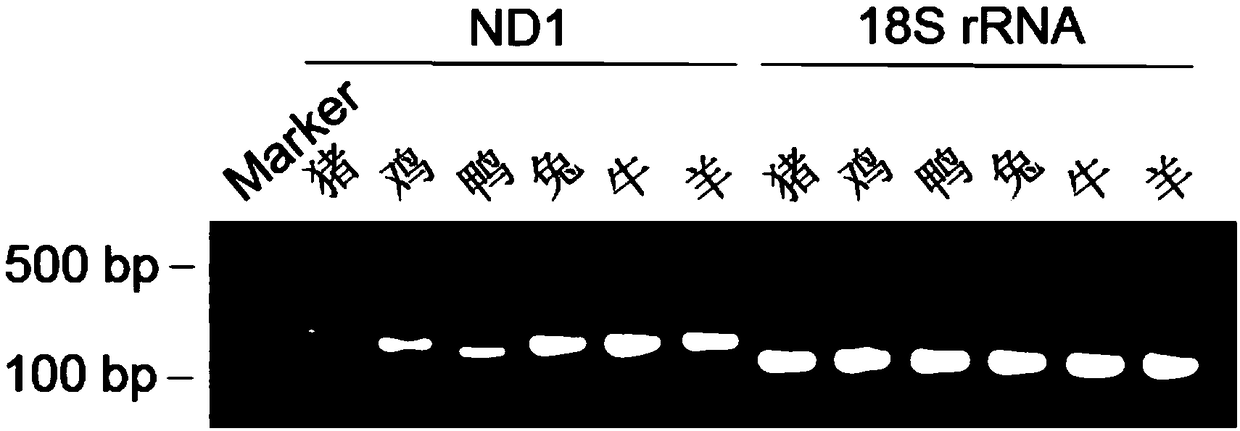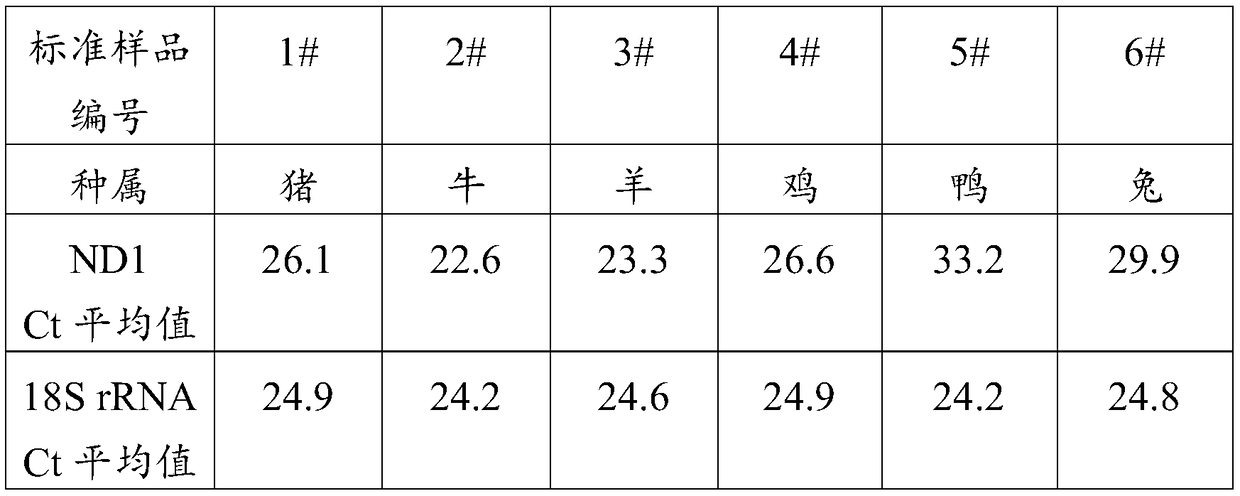Real-time quantitative PCR method for detecting components of meat product
A meat product, real-time quantitative technology, applied in biochemical equipment and methods, microbial determination/inspection, etc., can solve the problem of inaccurate identification results, and achieve the effect of accurate detection results
- Summary
- Abstract
- Description
- Claims
- Application Information
AI Technical Summary
Problems solved by technology
Method used
Image
Examples
Embodiment 1
[0084] Single component detection of embodiment 1 standard sample
[0085] (1) Preparation of raw materials:
[0086] Take 6 kinds of single-ingredient meat products as standard samples corresponding to the species sources of meat products, numbered 1#~6#, and the source species are respectively pig, cattle, sheep, chicken, duck and rabbit. Take about 1g.
[0087] (2) Genomic DNA extraction:
[0088] Cut pork, beef, mutton, chicken, duck and rabbit meat samples into 1.5mL centrifuge tube and 450μL lysate with sterile scissors, then add 50μL proteinase K, react at 55℃ for 2-4h , repeated blowing several times, centrifuged at 5000rpm for 2min, and took the supernatant; added an appropriate amount of saturated phenol, oscillated and mixed, extracted twice, centrifuged at 5000rpm for 2min, took the supernatant; added 200μL chloroform and extracted again Once, centrifuge at 5000rpm for 2min, take the supernatant; add 0.1 times the volume of 5M NaCl solution, mix well, then add 2...
Embodiment 2
[0108] Example 2 Detection of Meat Products Containing Mixed Components
[0109] (1) Preparation of raw materials:
[0110] Standard mutton, mutton kebab 1, mutton kebab 2 and mutton kebab 3 were used as meat product samples, each taking about 1g, and the preset components to be detected in the meat product samples were mutton, pork and duck.
[0111] (2) By the same method as in step (2) in Example 1, extract a total of 4 groups of genomic DNA from standard mutton, mutton skewers 1, mutton skewers 2 and mutton skewers 3.
[0112] (3) The sequences of 3 pairs of specific primers and 1 pair of 18S rRNA primers required for PCR amplification of the mitochondrial gene NADH oxidoreductase 1 (ND1) are as follows:
[0113] Pig ND1 upstream primer: 5'-CCGGACCTTTCGCCATATTC-3', pig ND1 downstream primer: 5'-GCTAGTGTTAGGGGCAGGAA-3', product size: 246bp;
[0114] Goat ND1 upstream primer: 5'-ACGTAGAATATGCTGCCGGA-3', goat ND1 downstream primer: 5'-GGGTAGGATGCTCGGATTCA-3', product size: ...
PUM
 Login to View More
Login to View More Abstract
Description
Claims
Application Information
 Login to View More
Login to View More - R&D
- Intellectual Property
- Life Sciences
- Materials
- Tech Scout
- Unparalleled Data Quality
- Higher Quality Content
- 60% Fewer Hallucinations
Browse by: Latest US Patents, China's latest patents, Technical Efficacy Thesaurus, Application Domain, Technology Topic, Popular Technical Reports.
© 2025 PatSnap. All rights reserved.Legal|Privacy policy|Modern Slavery Act Transparency Statement|Sitemap|About US| Contact US: help@patsnap.com



